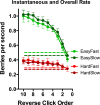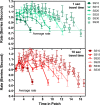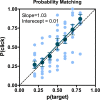When is it time to move to the next raspberry bush? Foraging rules in human visual search
- PMID: 23641077
- PMCID: PMC4521330
- DOI: 10.1167/13.3.10
When is it time to move to the next raspberry bush? Foraging rules in human visual search
Abstract
Animals, including humans, engage in many forms of foraging behavior in which resources are collected from the world. This paper examines human foraging in a visual search context. A real-world analog would be berry picking. The selection of individual berries is not the most interesting problem in such a task. Of more interest is when does a forager leave one patch or berry bush for the next one? Marginal Value Theorem (MVT; Charnov, 1976) predicts that observers will leave a patch when the instantaneous yield from that patch drops below the average yield from the entire "field." Experiments 1, 2, 3, and 4 show that MVT gives a good description of human behavior for roughly uniform collections of patches. Experiments 5 and 6 show strong departures from MVT when patch quality varies and when visual information is degraded.
Keywords: decision rules; foraging; marginal value theorem; visual attention; visual search.
Figures


















References
-
- Beck V. M., Hollingworth A., Luck S. J. (2012). Simultaneous control of attention by multiple working memory representations. Journal of Vision, 12 (9), 956, http://www.journalofvision.org/content/12/9/956, doi:10.1167/12.9.956. [Abstract] - PMC - PubMed
-
- Bond A. B., Kamil A. C. (2002). Visual predators select for crypticity and polymorphism in virtual prey. Nature, 415 (6872), 609–613. - PubMed
-
- Cain M. S., Vul E., Clark K., Mitroff S. R. (2011). A Bayesian optimal foraging model of human visual search. Psychological Science, 23, 1047–1054, doi:doi:10.1177/0956797612440460. - DOI - PubMed
-
- Charnov E. L. (1976). Optimal foraging, the marginal value theorem. Theoretical Population Biology, 9, 129–136. - PubMed
-
- Eckstein M. P. (2011). Visual search: A retrospective. Journal of Vision, 11 (5): 10 1–36, http://www.journalofvision.org/content/11/5/14, doi:10.1167/11.5.14. [PubMed] [Article] - PubMed
Publication types
MeSH terms
Grants and funding
LinkOut - more resources
Full Text Sources
Other Literature Sources

